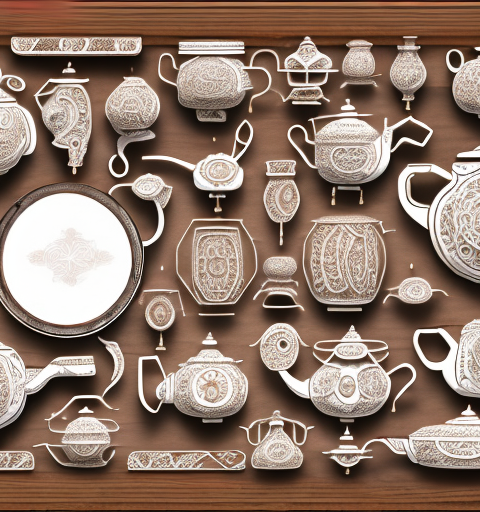In the tea-loving world, there’s nothing more disappointing than those stubborn tea stains that start to build up on the ceramic spout of your beloved teapot. Not only do they look unsightly, but they can also affect the taste of your tea. But fear not, because in this comprehensive guide, we will explore everything you need to know about removing tea stains from a ceramic spout of a teapot with a long pour spout.
Understanding the importance of cleaning tea stains from a teapot
Before we dive into the nitty-gritty of tea stain removal, it’s essential to understand why it’s crucial to keep your teapot spout clean. Over time, the tannins in tea can build up and leave stains, affecting the aesthetics of your teapot. Moreover, these stains can also impact the flavor of future brews by altering the taste of the tea. Therefore, regular cleaning of the ceramic spout is essential to preserve the appearance of your teapot and ensure a pleasant tea-drinking experience.
Additionally, neglecting to clean tea stains from your teapot can lead to the growth of bacteria and mold. The warm and moist environment inside the teapot provides an ideal breeding ground for these microorganisms. Not only can this compromise the hygiene of your teapot, but it can also pose health risks when consuming tea brewed in a contaminated teapot. By regularly cleaning and removing tea stains, you can prevent the growth of harmful bacteria and ensure that your teapot remains safe for use.
The challenges of removing tea stains from a ceramic spout
Cleaning tea stains from a ceramic spout can be a challenging task, primarily due to the porous nature of the material. The small pores in the ceramic can trap the tannins and make it difficult to remove the stains completely. Additionally, the narrow and intricate shape of the spout can be another hurdle to overcome. However, with the right tools, techniques, and a little patience, you can restore your teapot spout to its former glory.
One effective method for removing tea stains from a ceramic spout is to create a paste using baking soda and water. Apply the paste to the stained area and gently scrub with a soft brush or sponge. The abrasive nature of baking soda helps to lift the stains from the porous surface of the ceramic. Rinse thoroughly with water to remove any residue.
Another option is to use white vinegar, which is known for its natural cleaning properties. Fill a bowl or basin with equal parts white vinegar and water. Submerge the ceramic spout in the mixture and let it soak for several hours or overnight. The acidity of the vinegar helps to break down the tea stains, making them easier to remove. After soaking, scrub the spout with a brush or sponge and rinse well with water.
Tools and materials needed for cleaning tea stains from a teapot
Before you start the tea stain removal process, it’s essential to gather the necessary tools and materials. Here’s a list of items that will come in handy:
- Gentle dish soap or specialized teapot cleaner
- White vinegar or lemon juice
- Baking soda
- A soft sponge or brush
- Cotton swabs
- Paper towels
- Microfiber cloth
Having these items readily available will make the cleaning process more efficient and effective.
Additionally, it is recommended to have a kettle or pot for boiling water. Boiling water can be used to loosen stubborn tea stains and make them easier to remove.
Furthermore, having a small bowl or container to mix cleaning solutions can be helpful. This allows you to create a paste with baking soda or dilute vinegar or lemon juice with water for more effective cleaning.
Step-by-step guide to removing tea stains from a ceramic spout
Now that you’re armed with the necessary tools, let’s delve into the step-by-step process of removing tea stains from a ceramic teapot spout:
- Preparing the teapot for cleaning – emptying and rinsing:
Before you begin cleaning, make sure to empty any leftover tea from the teapot and rinse it with warm water.
- Choosing the right cleaning solution for tea stain removal:
Depending on the severity of the stains, you can opt for either a gentle dish soap or a specialized teapot cleaner. Both options are effective, but if you’re dealing with stubborn stains, a teapot cleaner may yield better results.
- Natural remedies for removing tea stains from a ceramic spout:
If you prefer to take a more natural approach, white vinegar or lemon juice can be an excellent alternative to chemical cleaners. Simply dilute the vinegar or lemon juice with water and use it as a cleaning solution.
- Using common household items to clean tea stains from a teapot:
In addition to specialized cleaners, you can also use everyday household items like baking soda to tackle tea stains. Create a paste by mixing baking soda with water and apply it to the stained areas. Let it sit for a few minutes before scrubbing gently with a soft sponge or brush.
- Proper scrubbing techniques to effectively remove tea stains:
When scrubbing the ceramic spout, it’s crucial to be gentle to avoid causing any damage. Use a soft sponge or brush and apply light pressure while scrubbing in circular motions. This will help to dislodge the stains without harming the surface of the ceramic spout.
- Soaking the ceramic spout for deep stain removal:
If the tea stains are particularly stubborn, you can try soaking the ceramic spout in a solution of warm water and dish soap or vinegar. Allow it to soak for a few hours or overnight to loosen the stains before gently scrubbing them away.
- Gentle cleaning methods for delicate ceramic spouts:
If your teapot has a delicate ceramic spout, it’s essential to handle it with care. Opt for milder cleaning solutions and avoid using abrasive materials that could scratch or damage the surface. Gentle wiping and dabbing with a soft cloth or cotton swab will suffice for removing stains from delicate spouts.
- Tips and tricks for preventing future tea stains on your teapot:
Prevention is always better than cure when it comes to tea stains. To minimize future staining, make sure to rinse the teapot with warm water immediately after each use. Additionally, avoid leaving brewed tea sitting in the teapot for extended periods.
- Maintaining the cleanliness and shine of your teapot’s ceramic spout:
Once you’ve successfully removed the tea stains, it’s essential to maintain the cleanliness and shine of the ceramic spout. Regularly wash the teapot, paying specific attention to the spout, and dry it thoroughly before storing.
- Troubleshooting common issues encountered during tea stain removal process:
During the tea stain removal process, you may encounter some issues such as stubborn stains that won’t come off or discoloration of the ceramic spout. In such cases, referring to expert advice or seeking professional assistance might be necessary.
- Expert advice on restoring heavily stained ceramic spouts of teapots:
If your teapot’s ceramic spout is heavily stained, and you’re not having success with DIY methods, it’s advisable to seek guidance from experts in teapot restoration. They can provide specialized techniques and products to rejuvenate your teapot.
- Alternative options for dealing with stubborn tea stains on a teapot’s spout:
If all else fails, and you’re unable to remove stubborn tea stains from a ceramic spout, you may want to consider replacing the spout altogether or exploring teapots with removable and replaceable parts.
- Exploring different types of teapots with long pour spouts and their cleaning requirements:
Teapots come in various shapes, sizes, and materials, each with its own unique requirements for cleaning. Exploring different types of teapots and their cleaning instructions will help you make an informed decision when purchasing a new teapot.
- The impact of neglecting to clean tea stains on the functionality of a teapot’s pour spout:
It’s important to note that neglecting to clean tea stains from your teapot’s ceramic spout can negatively impact its functionality. Over time, the buildup of tannins and stains may affect the flow of tea from the spout, leading to drips or uneven pouring. Regular and diligent cleaning will help maintain the functionality of your teapot.
- Aesthetic considerations – keeping your teapot’s ceramic spout spotless and beautiful:
Beyond functionality, the appearance of your teapot is an essential aspect of its overall aesthetic appeal. Keeping the ceramic spout spotless not only ensures a visually pleasing teapot but also reflects your dedication to the art of tea brewing.
Conclusion
Cleaning tea stains from the ceramic spout of a teapot with a long pour spout may require effort and attention to detail, but the results are well worth it. By following the step-by-step guide and utilizing the right tools and techniques, you can rejuvenate your teapot and enjoy fresh, stain-free tea. Remember, regular maintenance and prevention are key to keeping your teapot’s ceramic spout in pristine condition. So, embrace the challenge and say goodbye to those stubborn tea stains for good!
Not only does cleaning tea stains from the ceramic spout improve the appearance of your teapot, but it also helps to maintain the flavor of your tea. Over time, tea stains can build up and affect the taste of your brew. By regularly cleaning the spout, you can ensure that your tea retains its original flavor and aroma.
In addition to using the step-by-step guide, there are a few extra tips that can make the cleaning process even more effective. One tip is to soak the spout in a mixture of warm water and vinegar before scrubbing. The acidity of the vinegar helps to break down stubborn stains and makes them easier to remove. Another tip is to use a soft-bristled brush or toothbrush to gently scrub the spout, as harsh scrubbing can damage the ceramic surface.






